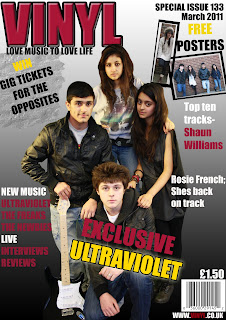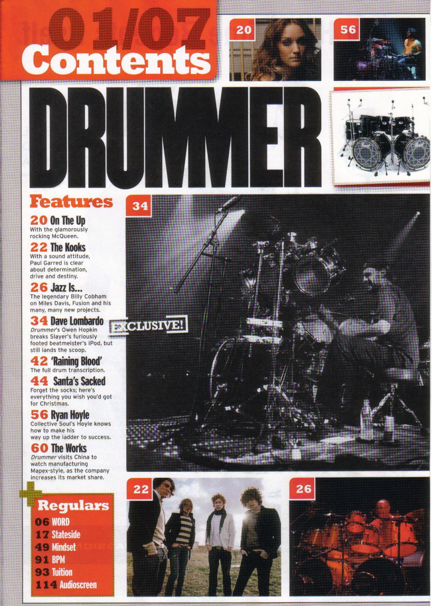This is a double page spread from a NME magazine which shows a band of 3 members; ‘The Teenagers’. The fact the article is called ‘The teenagers’ can directly appeal to young audiences. Besides the heading, it says “NME Loves” and this can not only target the specific audience group which NME specialise in (teenagers) but also encourage more people to buy the magazine. This puff will persuade the readers to read on. Also by the magazine recommending them would mean they are good as the company “loves” them.
The heading is large in blue block capitals places on a white background which grabs the audience’s attention. The colour used may attract the readers as they see things such as colours and images as important aspects in any type of magazine. This heading goes on top of the image which can indicate their importance. Underneath the heading is a slogan; “Young dumb and full of filthy tunes” which is quite catchy and can appeal to the youth encouraging them to read on. The slogan suggests many teenagers go against many norms and values in the wider society.
The double page spread consists of a large central image on the left which can be seen as conventional of other layouts in magazines. The image is of the band; ‘The Teenagers’ lying on a bed. The long shot allows us to see aspects such as mise-en-scene and colours. From the first glance of the 3 male’s the audience can assume they have something to do with a genre of Rock. From the mise-en-scene we can see there are many photos and posters on the wall which can imply teenager’s reminisced memories, by keeping them safe. The magazine here, relates to the target audience as many youngsters tend to have a bedroom which is similar to what is shown. We can probably assume this room is a male’s room as there are photos of women on the wall which many male teenagers have nowadays. The posters are places in different angels on the wall which signifies a “scruffy” look which is usually how Rock/Indie bands are like. All members of the band are dressed in a way which informs the genre of the magazine to the reader. They are dressed quite casual by wearing blue skinny jeans, t-shirts, leather jackets, and trainers which relates to many members of the target audience. This also connotes how people from rock bands, stereotypically dress. The male in the middle is wearing, as many teenagers would call “nerd glasses” and this tells us they are going for the “cool” look by looking casual yet sophisticated.
We can see all three of them are lying on a bed looking very relaxed which can stereotypically relate to the target audience of teenagers as they are seen as “lazy”. All three members are directly looking at the camera which is an example of direct address via a conformational stare which reinforces that the magazine are getting people to buy the magazine by involving the audience. This image overall can be seen as conventional image coming from an NME magazine as they are specifically used teenagers in the image allowing more young people to relate to this aswell as the heading.
Furthermore, ere are also other images used on the double page which can again be seen as typical features. The images are of other rock bands which make the page look encouraging as it promotes the band “The Teenagers”.
The article is in columns (a conventional way of writing text on a double page) however looks like it has been squashed between the image on the left and the text on the right which would draw the reader’s eye towards it. The writing is in white which stands out. The columns allow the text to look very structured and organised. A floating quote is also used which is not very noticeable. At the beginning of the article, the letter ‘T’ is in black, bold, large font which shows this is structured like a newspaper and draws attention towards this section.
Many colours are used such as white, blue and black. These colours can target male youngsters as they are quite dark, dull colours and this can be seen as stereotypical colours of what males like. The colour blue signifies a new start of youths which is the target audience of most ‘NME’ magazines. The background highlighted by the colour black can portray the view of teenage boys as dangerous or rebellious.
The ‘note’ at the bottom left, holds information about the band which informs the audience what they are reading about. On the right side of the double page, is a column of what ‘Everyone’s Talking about’ followed by 3 bands; Asobi Sesksu, Crystal Castles, and The Rascals which can be seen as a focus point of the magazine to the audience as it is separate from the main article of ‘The Teenagers’.
Overall, this double page spread can be seen as conventional of a ‘NME’ rock magazine in which the audience can relate to. The use of three main colours can specifically target teenagers.









































